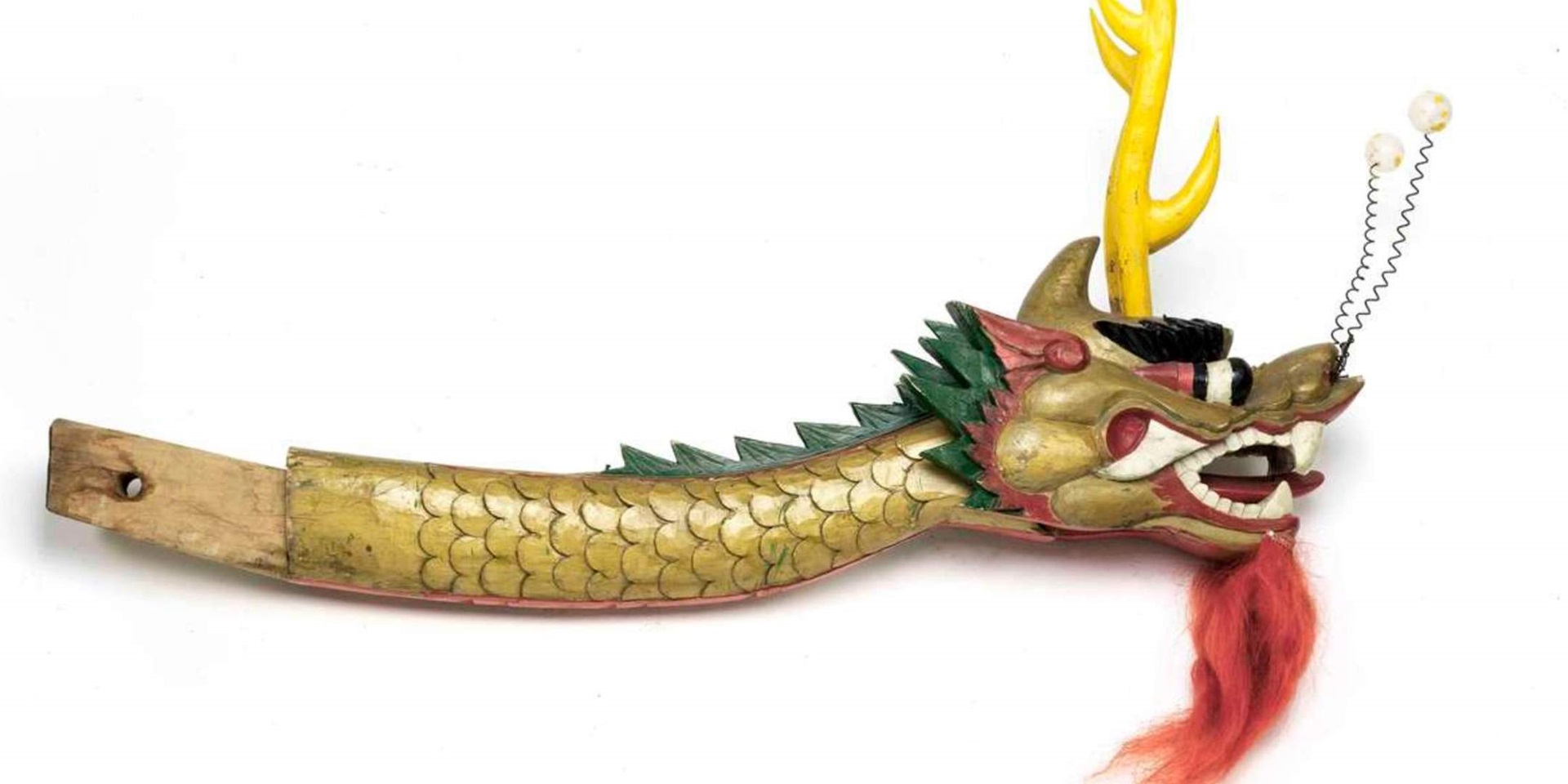

Dragon boat figurehead painted gold, green and beige with red beard and white plastic antennae. ANMM Collection 00039729. Gift from Carlos Ung.
It’s Lunar New Year and time to present the colour and excitement of ancient Chinese culture from the museum’s collections. Dragons feature heavily. And so does racing. (I know that it’s the Year of the Rooster, but they don’t usually like water …)
Dragons have been a potent symbol of Chinese culture for thousands of years – people believed they lived in rivers and lakes and controlled the rains and crops. They were mostly protective, yet when angered created havoc with floods and drought. Chinese communities honoured the dragons with festivals and sacrifices to keep the river dragon happy.
Dragon boat racing has its origins in 278 BC, and the dragon boat festival was traditionally held on the fifth day of the fifth lunar month. Legend locates its origins in the commemoration of the death of China’s great poet Qu Yuan. It combines Taoist principles with elements of dragon worship.
The most powerful kingdoms of the so-called warring states period were Chu and Qin. Qu Yuan (340–278 BC) was an advisor the King of Chu. In an episode of palace intrigue, he was exiled for allegedly treacherous advice when, suspecting foul play, he advised against signing a peace deal with the state of Qin. His advice was not taken, the peace treaty was signed, and it eventually proved to be a trap – the state of Chu was conquered by the Qin army. According to legend, Qu Yuan threw himself into the Miluo River in Southern China in despair at the fall of his beloved state of Chu.
Hearing this, people raced out in their dragon boats beating drums and splashing their paddles in desperate attempts to prevent the river dragon and the fish from eating his body. They threw rice into the water both to feed Qu Yuan’s spirit and as an offering to the river dragon. The festival has been held every year since.
Many ancient cultural rituals are observed in racing here in Australia. The boats themselves are long (at nearly 12 metres) and narrow (just over a metre), like a dragon, with its head and tail as decorative and symbolic features – a figurehead at the bow, and a tail at the stern. The paddles replace the dragon’s claws. Today there are 20 paddlers, a sweep to steer and a drummer.
The head and tail of the dragon are fitted to the boats before the racing in an important cultural ritual that awakens the dragon. Taoist priests conduct the ceremony, chanting and burning candles, incense and paper money at an altar to ward off evil, bless the boat and bring good luck. Food and wine are offered at the altar. The ‘dotting the eyes’ ceremony follows, in which the priest and prominent members of the community paint the eyes of the dragon head with red paint to bring the dragons to life.
After the races the head and tail of each boat are removed.
One of the most popular of the ancient cultural rituals associated with the dragon boat festival is the making and eating of rice dumplings, or zhong zi – soft sticky rice encased in bamboo leaves and tied with string – to commemorate of the drowning of Qu Yuan.

This small fibreglass model of a dragon boat was built by Rocky SS Wong in Australia. This model is based on the lines of the boats that are paddled in Australia – long and narrow, like a dragon, with its head and tail as decorative and symbolic features. ANMM Collection 00033514.
Dragon boat racing has flourished in countries around the world after it was promoted outside China in the 1980s.
Australia’s formal introduction to the sport came in 1980, when a surf life saving team from Western Australia was invited to compete in the Penang Dragon Boat Festival in Malaysia. Dragon boat clubs formed around the country with competitors from both Chinese and varied cultural backgrounds, young and old, corporate and recreational. In 2003 the sport was officially recognised by the Australian Sports Commission. This gave Australian paddlers permission to wear the Australian Coat of Arms on their uniforms – official recognition for a sport that had come a long way comparatively quickly in Australia.
![Dragon Boat racing on Darling Harbour, Sydney. Image: Saberwyn (Own work) [CC BY-SA 3.0 (http://creativecommons.org/licenses/by-sa/3.0)], via Wikimedia Commons.](https://s3-ap-southeast-2.amazonaws.com/anmm-data/blog/2017/01/27/darling_harbour_dragon_boat.jpg)
Dragon Boat racing on Darling Harbour, Sydney. Image: Saberwyn (Own work) [CC BY-SA 3.0 (http://creativecommons.org/licenses/by-sa/3.0)], via Wikimedia Commons.


